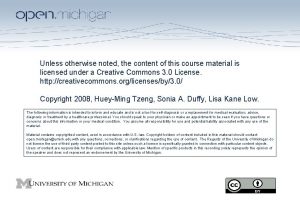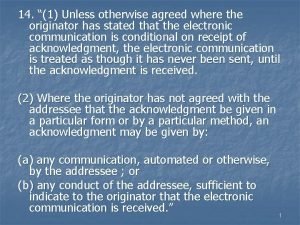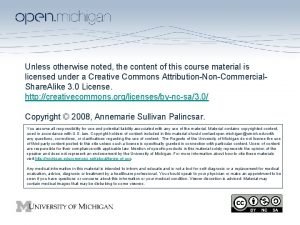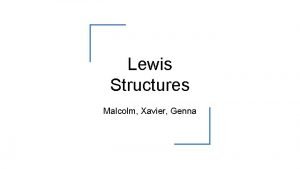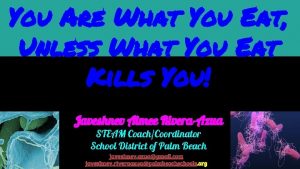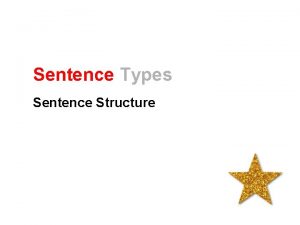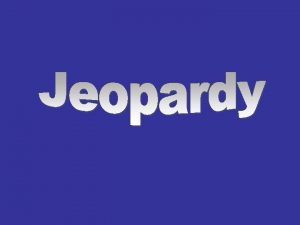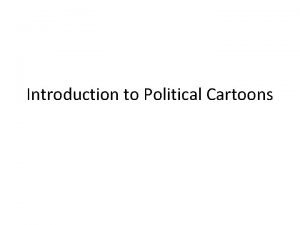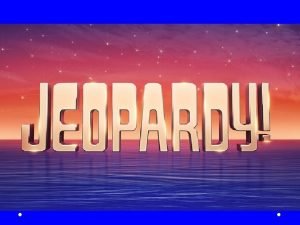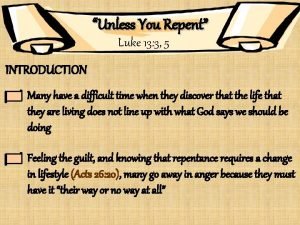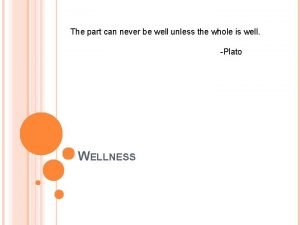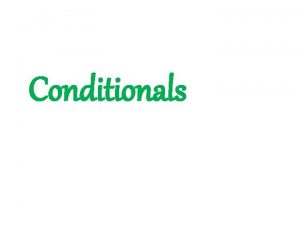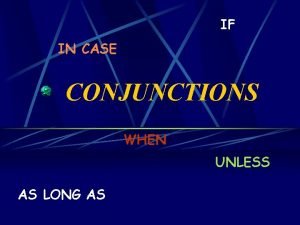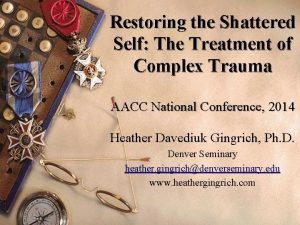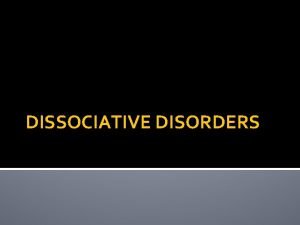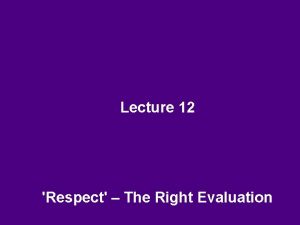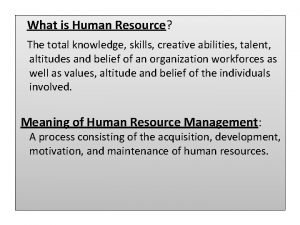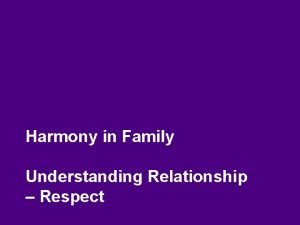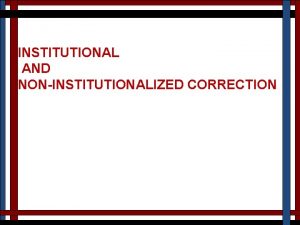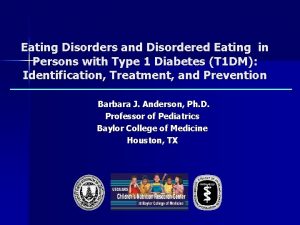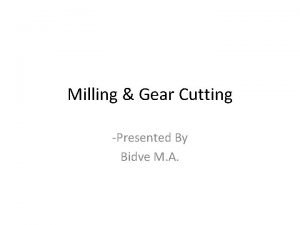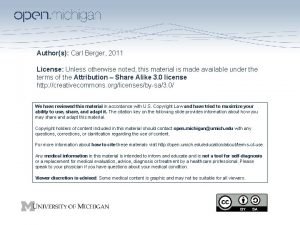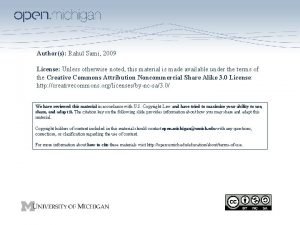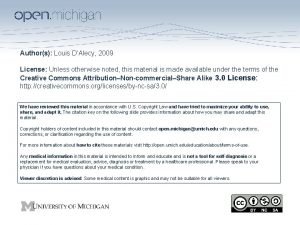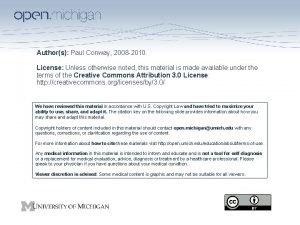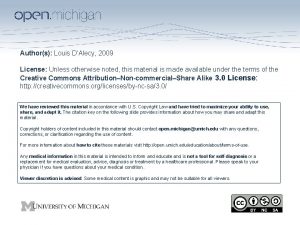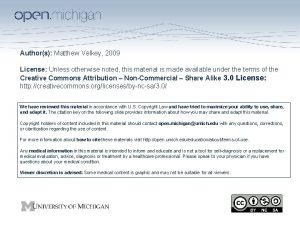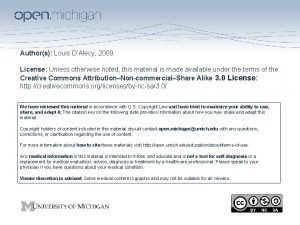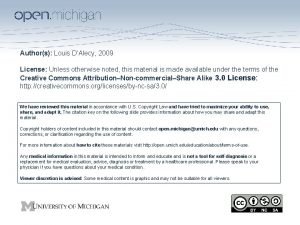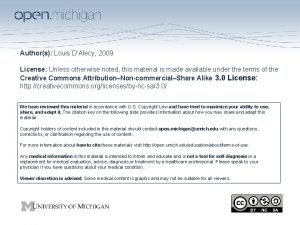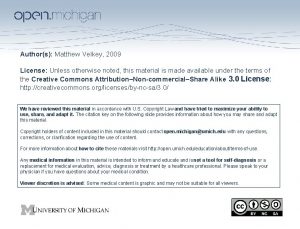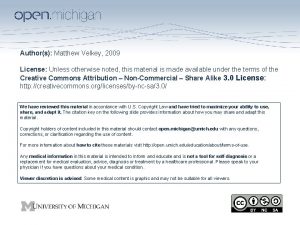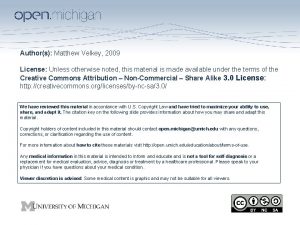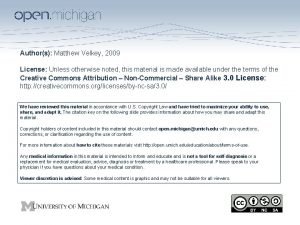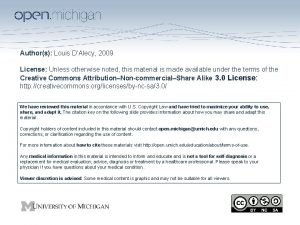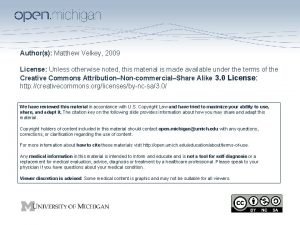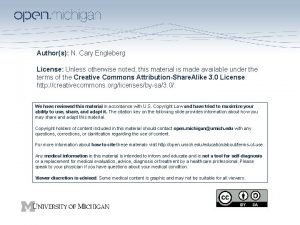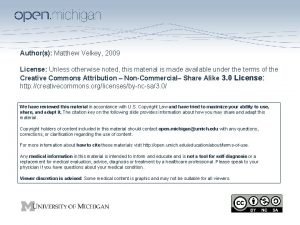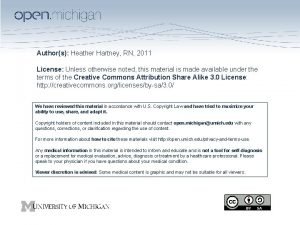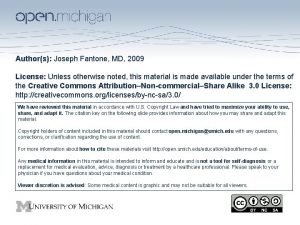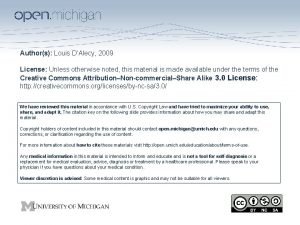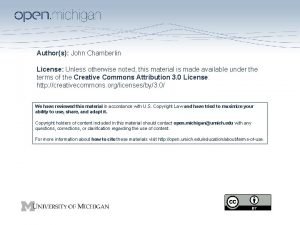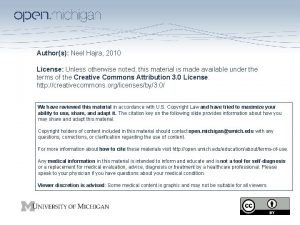Authors Genna R Cohen 2013 License Unless otherwise
































- Slides: 32

Author(s): Genna R. Cohen, 2013 License: Unless otherwise noted, this material is made available under the terms of the Creative Commons Attribution-Non. Commercial-Share. Alike 3. 0 License: http: //creativecommons. org/licenses/by-nc-sa/3. 0/ We have reviewed this material in accordance with U. S. Copyright Law and have tried to maximize your ability to use, share, and adapt it. The citation key on the following slide provides information about how you may share and adapt this material. Copyright holders of content included in this material should contact open. michigan@umich. edu with any questions, corrections, or clarification regarding the use of content. For more information about how to cite these materials visit http: //open. umich. edu/education/about/terms-of-use. Any medical information in this material is intended to inform and educate and is not a tool for self-diagnosis or a replacement for medical evaluation, advice, diagnosis or treatment by a healthcare professional. Please speak to your physician if you have questions about your medical condition. Viewer discretion is advised: Some medical content is graphic and may not be suitable for all viewers.

Citation Key for more information see: http: //open. umich. edu/wiki/Citation. Policy Use + Share + Adapt { Content the copyright holder, author, or law permits you to use, share and adapt. } Public Domain – Government: Works that are produced by the U. S. Government. (17 USC § 105) Public Domain – Expired: Works that are no longer protected due to an expired copyright term. Public Domain – Self Dedicated: Works that a copyright holder has dedicated to the public domain. Creative Commons – Zero Waiver Creative Commons – Attribution License Creative Commons – Attribution Share Alike License Creative Commons – Attribution Noncommercial Share Alike License GNU – Free Documentation License Make Your Own Assessment { Content Open. Michigan believes can be used, shared, and adapted because it is ineligible for copyright. } Public Domain – Ineligible: Works that are ineligible for copyright protection in the U. S. (17 USC § 102(b)) *laws in your jurisdiction may differ { Content Open. Michigan has used under a Fair Use determination. } Fair Use: Use of works that is determined to be Fair consistent with the U. S. Copyright Act. (17 USC § 107) *laws in your jurisdiction may differ Our determination DOES NOT mean that all uses of this 3 rd-party content are Fair Uses and we DO NOT guarantee that your use of the content is Fair. To use this content you should do your own independent analysis to determine whether or not your use will be Fair.

COURSE MAP-WEEK 10 5 Lectures i 6 5 DOMAINS 10 METHODS 4 INFO. RESOURCES ON YOUR OWN ii EHRs (Vist. A) Elements & functions of Info. Systems Skill Modules time HIT STANDARDS

S N O Z I N I T A 8 6 6 F F A O N G T I H R T O N I L E O B A M RE E – E H 2 G A 4 O A C 5 T I AN LTH N S 3 O M EA – 1 I 0 T S 8 2 C C 6 H 6 U T I D A R O M R M E H B T OR N M F I E N V I O N P 6, Genna R. Cohen, HSOP grcohen@umich. edu

BACKGROUND: WHO I AM Ph. D Candidate in Health Services Organization and Policy § School of Public Health § Studying physician practices; HIT Research Analyst at the Center for Studying Health System Change § Researched physician practices; HIT; health insurance § Washington, DC 5

AGENDA: WHAT ARE WE GOING TO DO 1. Why Organizations? 2. Background about Healthcare Organizations 3. Management Issues in Healthcare Organizations 4. IT Issues and Healthcare Organizations 5. Methods of Studying Organizations 6

ARE ORGANIZATIONS IMPORTANT? “Question Box” by Raymond Bryson 7

ARE HEALTH CARE ORGANIZATIONS UNIQUE? Similarities to other human services organizations (ex: social work; advocacy; education) 1. Moral nature of work 2. Atypical relationship with clients (like students) (Martin, Lassman, Washington, Catlin, & Team, 2012), (Hasenfeld, 1992), (Burns, 8 Bradley, & Weiner, 2011).

ARE HEALTH CARE ORGANIZATIONS UNIQUE? Differences from other human services organizations: § 18% of 2010 GDP and growing – 2 nd largest industry in the US! § Unique combination of attributes: 1. Difficulty defining and measuring outcomes 2. Variable and complex work 3. Emergent and nondeferrable work 4. Little tolerance for ambiguity or error 5. Professional autonomy 6. Organizations do not always employ their members 7. Interdependencies among staff (Martin, Lassman, Washington, Catlin, & Team, 2012), (Hasenfeld, 1992), (Burns, 9 Bradley, & Weiner, 2011).

US HEALTHCARE SYSTEM Government Employer Patient Provider Insurer 10

KEY CHARACTERISTICS OF HEALTH CARE PROVIDER ORGANIZATIONS • Size • Affiliation with other organizations • Geographic location • Rural vs. Urban • Safety net status • Teaching status • Not-for-profit vs. For-profit (“investor-owned”) • Culture, leadership, payer mix 11

RELATIONSHIPS BETWEEN ORGANIZATIONS Clinic 2° Community (District) Hospital 3° Medical Center 1° Health Center Slide courtesy of Rich Lichtenstein, 2010 12

Image Removed Due to Copyright BOUKUS, ELLYN, ALWYN CASSIL AND ANN S. O’MALLEY, A SNAPSHOT OF U. S. PHYSICIANS: KEY FINDINGS FROM THE 2008 HEALTH TRACKING PHYSICIAN SURVEY, DATA BULLETIN NO. 35, CENTER FOR STUDYING HEALTH SYSTEM CHANGE, WASHINGTON, D. C. (SEPTEMBER 2009). 13

COMMUNITY HOSPITALS BY BED SIZE, 2008 51% of US hospitals are under 100 beds Source: AHA Hospital Statistics, 2009 14

HOSPITAL-PHYSICIAN TRENDS 2000 -2008 0, 4 0, 35 Employment 0, 3 0, 25 0, 2 0, 15 Open Physician-Hospital Org Independent Practice Association 0, 1 Management Service Organization CPHO Group practice without walls 0, 05 0 2001 2002 2003 2004 2005 2006 2007 2008 Source: American Hospital Association annual survey 15

AGENDA: WHAT ARE WE GOING TO DO 1. Why Organizations? 2. Background about Healthcare Organizations 3. Management Issues in Healthcare Organizations 4. IT Issues and Healthcare Organizations 5. Methods of Studying Organizations 16

MANAGEMENT ISSUES IN ORGANIZATIONS 1. Leadership and decision-making • Autocratic • People-oriented • Bureaucratic /relations-oriented • Charismatic • Servant • Democratic/ • Task-oriented participative • Transactional • Laissez-faire • Transformational 17

MANAGEMENT ISSUES IN ORGANIZATIONS 1. Leadership and decision-making 2. Culture § Competing values around • • Collaboration Competition Creation Control 18

MANAGEMENT ISSUES IN ORGANIZATIONS 1. Leadership and decision-making 2. Culture 3. Integration/Relationship with Other Organizations • Physician Organization: Multiple Practices • Physician-Hospital Organization: Hospitals + Physician Practices • Integrated Delivery System: Health Plan + Providers • ACOs 19

AGENDA: WHAT ARE WE GOING TO DO 1. Why Organizations? 2. Background about Healthcare Organizations 3. Management Issues in Healthcare Organizations 4. IT Issues and Healthcare Organizations 5. Methods of Studying Organizations 20

HEALTH CARE ORGANIZATIONS’ IT NEEDS 1. Operational (e. g. , bill paying, medical history) 2. Planning (population management) 3. Communication (handoffs) 4. Documentation and reporting (joint commission audits) 5. Ability to use IT to transform and innovate (ACOs/PCMH) 21

COMPETING IT PRIORITIES IN HCOS 1. Clinical vs. administrative needs § Who is paying? § Who is using? 2. Primary vs. secondary use 3. Current documentation care vs. future decisionmaking 4. HIPAA 22

TODAY, LET’S COMPARE… Small Large Suburban Urban Independent Primary care practice System Hospital 23

COMPARE AND CONTRAST IT ISSUES… • What are the IT priorities of these organizations? • What policy issues should they be concerned about Small Independent Suburban PCP • Who makes decisions? • How do you reach consensus? • What type of support do they have? • How does that affect the systems they buy? Vs Large Urban Hospital System 24

AGENDA: WHAT ARE WE GOING TO DO 1. Why Organizations? 2. Background about Healthcare Organizations 3. Management Issues in Healthcare Organizations 4. IT Issues and Healthcare Organizations 5. Methods of Studying Organizations 25

HOW WE STUDY ORGANIZATIONS Organization studies Organizational Theory (Macro) Organizational Behavior (Micro) 26

WHAT DO WE WANT TO KNOW ABOUT ORGANIZATIONS? ORGANIZATION THEORY ORGANIZATION BEHAVIOR • Why don’t all organizations look the same? • How do you motivate people in organizations? • Can organizations change, or must new ones replace ineffective ones? • What makes a good leader? What are the impacts of good leadership? 27

HOW DO WE ANSWER THESE QUESTIONS? 1. Surveys § Who do you survey? § More than one person per organization? § Same person multiple times? 28

HOW DO WE ANSWER THESE QUESTIONS? 1. Surveys 2. Interviews and site visits § How do you select cases? § What type of information are you recording? 29

HOW DO WE ANSWER THESE QUESTIONS? 1. Surveys 2. Interviews and site visits 3. Linking together secondary datasets § Analyzing publicly available information – CEOs, boards of directors, stockholder reports § Market share and other performance metrics § What organizations are left out of this approach? 30

K N A ! U YO TH Q U E S T IO N S ? Genna R. Cohen, HSOP grcohen@umich. edu

IMAGE ATTRIBUTIONS • • • • “Question Box” by Raymond Bryson is under a Creative Commons license CC BY 2. 0. “Pharmacy mortar and pestle 2” by J_Alves is in the Public Domain. “Wood Table” by ozerkavak is in the Public Domain. “Woman Doctor” by Gerald_G is in the Public Domain. “PC back” by yyycatch is in the Public Domain. “PC front” by yyycatch is in the Public Domain. “Doctor” by moself is in the Public Domain. “After the stroke” by moini is in the Public Domain. “Thomasville Medical Center” by Novant Health is under a Creative Commons license CC BY-SA 3. 0. “Alaska Anchorage Community Hospital 1972 01” by Piergiuliano Chesi is under a Creative Commons license CC BY 3. 0. “VSU Health Center” by Jadvii is under a Creative Commons license CC BY 3. 0. “Dzhida (Clinic) by Аркадий Зарубин is under a Creative Commons license CC BY-SA 3. 0. “Balance Scale” by Gerald_G is in the Public Domain. “Pear” by matou is in the Public Domain. “apple” by matou is in the Public Domain. 32
 Huey-ming tzeng
Huey-ming tzeng Unless otherwise agreed
Unless otherwise agreed Unless otherwise noted meaning
Unless otherwise noted meaning Unless noted otherwise
Unless noted otherwise Azeureus
Azeureus Genna miller
Genna miller Cl2cs lewis structure
Cl2cs lewis structure Unless what
Unless what Sentences that start with unless
Sentences that start with unless Sandy feels dirty unless she bathes and changes
Sandy feels dirty unless she bathes and changes Unless
Unless Lisp unless
Lisp unless One sees his finish unless good government retakes the ship
One sees his finish unless good government retakes the ship Romeo and juliet act 1 jeopardy
Romeo and juliet act 1 jeopardy I’m sorry that i didn’t finish my homework last night.
I’m sorry that i didn’t finish my homework last night. Luke 13:3-5
Luke 13:3-5 The part can never be well unless the whole is well meaning
The part can never be well unless the whole is well meaning Oraciones subordinadas condicionales
Oraciones subordinadas condicionales Slum as big as doom literary devices
Slum as big as doom literary devices A unless b
A unless b Lisp unless
Lisp unless In case unless
In case unless Unless you repent you will all likewise perish
Unless you repent you will all likewise perish Bask model of dissociation
Bask model of dissociation Dissociative amnesia
Dissociative amnesia Respect is over evaluation
Respect is over evaluation Hermanson unpurchased goodwill model
Hermanson unpurchased goodwill model Ra 9344 cases
Ra 9344 cases Respect is right evaluation
Respect is right evaluation The co-author of congressman natividad in house bill 393.
The co-author of congressman natividad in house bill 393. 10912
10912 Dissociative disorder not otherwise specified
Dissociative disorder not otherwise specified Gears types
Gears types
